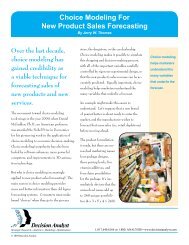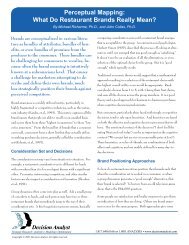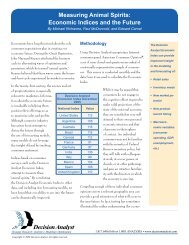The Role of Idea-Centric Creativity - Decision Analyst, Inc.
The Role of Idea-Centric Creativity - Decision Analyst, Inc.
The Role of Idea-Centric Creativity - Decision Analyst, Inc.
Create successful ePaper yourself
Turn your PDF publications into a flip-book with our unique Google optimized e-Paper software.
Using Consumers to Fuel Your New Product GenerationPipeline: <strong>The</strong> <strong>Role</strong> <strong>of</strong> <strong>Idea</strong>-<strong>Centric</strong> <strong>Creativity</strong>By Leyla Namiranian and Gwen Ishmael<strong>The</strong> Case for New Product InnovationWe live in a world in which the ability <strong>of</strong> an organization to surviveis defined by its capacity to innovate. Companies must bringsuccessful new products to market almost constantly. In fact, thespeed at which innovation takes place today is faster than ever,a trend that may have started in the high-tech industry, but isnow a fact <strong>of</strong> business life for all industries.<strong>The</strong> average consumer packaged goodscompany now introduces 70 to 80 newproducts per year; Procter & Gamble <strong>of</strong>fers46 different types <strong>of</strong> Tide in the U.S. 1 Andshorter product lifecycles and an increasinglycompetitive environment are globaltrends, not limited to the United States.<strong>The</strong> speed at which innovationtakes place today is faster thanCompetitive environments and shorterproduct lifecycles also mean that, first, ato the United States.company needs to have the various versionsand extensions <strong>of</strong> its current productsready to release quickly. Second, in order to maintain competitiveadvantage, a company must also have its next-generation products—thenext “new thing” that customers will want to buy in ayear or two or three—in the pipeline while its current successfulproducts are still selling well.ever. <strong>The</strong> average consumer packagedgoods company now introduces70 to 80 new products per year.Shorter product lifecycles and anincreasingly competitive environmentare global trends, not limitedCompanies must also be able to spot opportunities for, and thenbe able to develop, truly disruptive innovations—the breakthroughproducts that may reshape their entire market and productcategory. To miss these opportunities would mean losing categoryleadership position. For example, skincare consumers areaccustomed to seeing new creams continuously introduced, each<strong>of</strong> which promises a definite improvement in the fight againstaging skin by virtue <strong>of</strong> the addition <strong>of</strong> a new ingredient. But consumersare not accustomed to the emergence <strong>of</strong> a new productthat will actually replace conventional skincare routines. However,the march <strong>of</strong> progress demands that such breakthrough productsbe developed, and the company that successfully developsthem will have a competitive edge.It Takes a Lot <strong>of</strong> <strong>Idea</strong>s to Create a SuccessfulNew ProductSo how does a company keep on top <strong>of</strong> this punishing innovationagenda? First, it is vitally importantto keep the new product pipeline filledwith potential new product ideas to develop,because many, many new productideas either do not see the light <strong>of</strong> releaseday or are not successful. How fulldoes the pipeline need to be? A Dun &Bradstreet study revealed that for eachsuccessful new product introduced, acompany needs between 50 and 60 othernew product ideas in the pipeline 2 . Or,one in every 60 or so new product ideas acompany generates will go on to becomea successful new product.So clearly the first step in succeeding at today’s innovation agendais to get lots <strong>of</strong> new product ideas into the pipeline. Havinglots <strong>of</strong> ideas here, in what some refer to as the “fuzzy front end”<strong>of</strong> new product development—where it is appropriate to generateand expand on ideas before converging on the best prospects andcontinuing through the development process—can make thedifference between success and failure at innovation.However, generating new product ideas is no easy thing to do.First, generating ideas is not a linear process, which means theusual, logical problem-solving approaches don’t always work wellwhen it comes to generating ideas. And companies can get sidetrackedby the sheer pressure—to find the “perfect” idea, to findthe “big” idea, and to move quickly. Finally, companies may findit difficult to get past their own unwillingness to take a risk on anew product idea.Strategic Research • Analytics • Modeling • OptimizationCopyright © 2003 <strong>Decision</strong> <strong>Analyst</strong>. All rights reserved.1.817.640.6166 or 1.800. ANALYSIS • www.decisionanalyst.com
Table 1Age Range <strong>Idea</strong>-<strong>Centric</strong> <strong>Creativity</strong> Index18-24 11425-34 10935-44 10645-54 9355-64 7765 or older 53Also, gender is a poor predictor <strong>of</strong> idea-centric creativity. Menand women appear to be roughly equal, although each sex doesbetter in product categories where their interests and relevant experiencesare concentrated. Similarly, ethnicity is a poor predictor<strong>of</strong> exceptional creativity. Education does tend to positively correlatewith exceptional creativity, but the degree <strong>of</strong> correlation isnot strong. That is, the college-educated tend to score higher thanhigh school graduates, but the difference is not great. Many consumerswith high school or less education tend to be very creative.Other types <strong>of</strong> creativity (artistic, musical, literary, theatrical)are not very predictive <strong>of</strong> “idea-centric” creativity. No matterhow we manipulated the regression techniques, the other types<strong>of</strong> creativity (musical, literary, artistic, alone or in combination)never showed up as significant variables in predicting idea-centriccreativity.<strong>The</strong>se new-product creatives look like everyone else, dress likeeveryone else, and talk like everyone else. But they are unique inone special way: Ask them to come up with new product ideas,and they (on average) are more than 10 times as productive as theaverage person. <strong>The</strong>y are also intrinsically motivated to <strong>of</strong>fer newideas, as opposed to being motivated by extrinsic factors such asfinancial reward. Coming up with new product ideas is fun forthem, and it’s something they enjoy spending time doing.Imaginators®—An Online Panel <strong>of</strong> <strong>Idea</strong>-<strong>Centric</strong>CreativesAs a result <strong>of</strong> our initial testing, we have built a consumer panelcalled Imaginators®, comprising more than 2,000 idea-centriccreatives in the U.S. and Europe who can help generate newproduct ideas. Imaginators® panelists represent the top 4% <strong>of</strong> thepopulation in terms <strong>of</strong> idea-centric creative ability. In addition,Imaginators® members receive ongoing training to enhance theirnatural creative skills, and their performance on projects is continuouslyassessed to ensure that for any given project, we are onlyusing the top performers.How do we use these top-performing creatives? First, most <strong>of</strong> ourprojects take place in an online environment. While demographicsare not important in terms <strong>of</strong> determining levels <strong>of</strong> creativity,they do take on some importance when it comes to generatingnew product ideas. Consumer creativity pioneer Foy Conwayput it best: “<strong>Creativity</strong> anchored in real-life experiences andreal consumer needs produces more ideas—and more relevantideas.” 6 Dr. Teresa Amabile’s model <strong>of</strong> the creativity processincludes “domain-relevant knowledge” <strong>of</strong> the subject at hand asjust an important a part <strong>of</strong> the creativity process as creative skills. 7In terms <strong>of</strong> new product ideation, domain relevant knowledgetranslates into product-category usage experience. Our 2,000+member Imaginators® panel is designed so that we can select projectparticipants based on factors such as product category usageor demographics. By making the ideation session online and notin a specific geographic location, we have a larger number andvariety <strong>of</strong> panelists available for projects.A Creative Process Results in Lots <strong>of</strong> Creative<strong>Idea</strong>sAnother important component <strong>of</strong> the creative process is the environmentin which creativity takes place. Among the importantfactors are stimulation, a process-oriented approach, and a sense<strong>of</strong> community. 8 Building on this research, we have created anonline environment that encourages creativity. We use provencreativity techniques that we have adapted to online use. Ourtrained Innovation Services facilitators guide the creative processto maximize the number and quality <strong>of</strong> ideas generated. <strong>The</strong> endresult is hundreds <strong>of</strong> innovative new product ideas that are rootedin consumer needs and wants.Once the online session is over, the Innovation Services teamspends days filtering and focusing on these hundreds <strong>of</strong> ideas andidea fragments, which can also be used to complement any internalideation efforts. After the development phase, generally 10 to20 <strong>of</strong> the resulting ideas will have been developed into full-blownnew product concepts, ready for marketing research testing.Through these sessions some major new brands, such as PurinaOne®, disposable Polaroids, and many others have come to life.Using Consumers To Fuel Your New Product Generation Pipeline
Just one ideation project with Imaginators® consumer panelistscan result in 20 new product ideas in development. This processcan surely help fill a company’s new product ideas pipeline. Andfilling that pipeline with ideas that can be honed through developmentinto new products that have as great a chance at successas possible is the way to stay on top <strong>of</strong> today’s innovation agenda.That innovation agenda demands that companies generateenough new product ideas to develop successful new next-generationproducts, as well as enough ideas to give the company a reasonablechance <strong>of</strong> being the one to come up with truly disruptiveinnovations—the breakthrough products that may reshape theirentire market and product category. <strong>Decision</strong> <strong>Analyst</strong>’s InnovationServices and Imaginators® bring the benefits <strong>of</strong> consumerdriven,idea-centric creativity to today’s innovation agenda.Notes1.2.3.4.Forrester Research (2002), “Demand Forecasting DoneRight.”Dun & Bradstreet (1998), London. . Amabile, Teresa M.,<strong>Creativity</strong>In Context (1996), Westview Press, p. 38.A pioneer researcher in the field <strong>of</strong> creative studies, Dr. E.Paul Torrance developed the “Torrance Test for CreativeThinking,” which is still <strong>of</strong>ten used to identify individual creativepotential. Torrance was also instrumental in developingmethods <strong>of</strong> creativity skills training. Specific Torrance sourcesinclude Torrance, E.P., (1974), “Torrance Tests Of CreativeThinking: Norms And Technical Manual,” Scholastic TestingServices, and Torrance, E.P. and Presbury, J. (1984), “Criteria5.6.7.8.Of Success Of 242 Recent Experimental Studies Of <strong>Creativity</strong>,”Creative Child Quarterly, 30, pp. 15-19.Parnes, S.J., and Noller, R.B. (1972), “Applied <strong>Creativity</strong>: <strong>The</strong>Creative Studies Project-Part 11,” Journal Of Creative Behavior,vol. 6, p. 164-186.Foy Conway, quoted from a 2002 working session with <strong>Decision</strong><strong>Analyst</strong>.Amabile, p. 113.Amabile, p. 231-232.AuthorsGwen Ishmael, Senior Vice President and leader <strong>of</strong> the <strong>Decision</strong><strong>Analyst</strong> Insights & Innovation Group, has led productdevelopment activities since 1992. Most notably, Ms. Ishmael isone <strong>of</strong> the founders <strong>of</strong> uswestdex.com, one <strong>of</strong> the Internet’s firstand most successful online yellow pages and local e-commercedirectories. She also conceived and developed groundbreakingWeb-based promotional vehicles, two <strong>of</strong> which are patent pending,and has been described as a “pioneer in the field <strong>of</strong> Internetmarketing.” Ms. Ishmael possesses more than 17 years <strong>of</strong> marketingexperience across a variety <strong>of</strong> industries, from s<strong>of</strong>twareto publishing to consumer products. She holds an MBA fromthe prestigious Daniel’s College <strong>of</strong> Business at the University <strong>of</strong>Denver, and is the recipient <strong>of</strong> numerous pr<strong>of</strong>essional awards recognizingher marketing and leadership achievements.Presented to the ESOMAR World Congress 2003, Prague,Czech Republic, September 16 2003About the AuthorGwen Ishmael is a Senior Vice President <strong>of</strong> Insights & Innovation at <strong>Decision</strong> <strong>Analyst</strong>. <strong>The</strong> author may be reached byemail at Gishmae@decisionanalyst.com or by phone at 1-800-262-5974 or 1-817-640-6166.<strong>Decision</strong> <strong>Analyst</strong> is a leading international marketing research and analytical consulting firm. <strong>The</strong> company specializesin advertising testing, strategy research, new product ideation, new product research, and advanced modeling formarketing-decision optimization.Strategic Research • Analytics • Modeling • Optimization604 Avenue H East • Arlington, TX 76011-3100, USA1.817.640.6166 or 1.800. ANALYSIS • www.decisionanalyst.comCopyright © 2003 <strong>Decision</strong> <strong>Analyst</strong>. All rights reserved.





